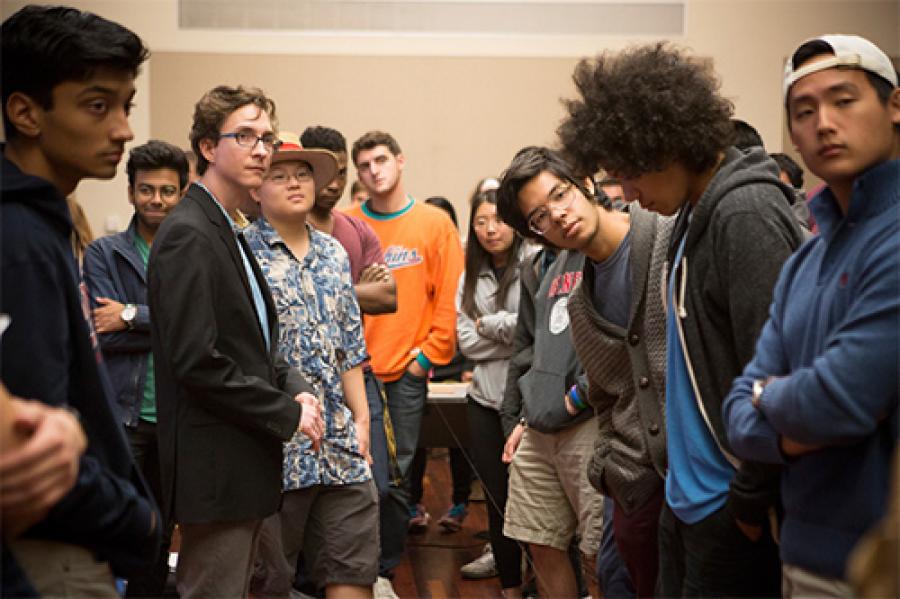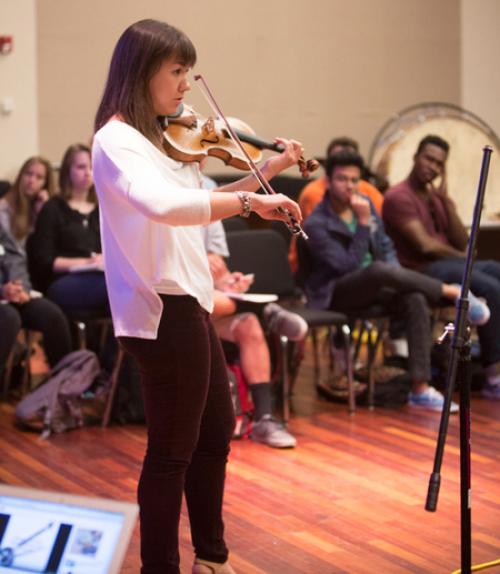Today’s music majors at Cornell will find a more flexible route through the program and a new emphasis on improvisation and other techniques to stretch their musical muscles in new ways.
“We’re developing a totally new way of understanding how musical language works,” said Roger Moseley, assistant professor and chair of the music department’s curriculum committee. “There’s a strong legacy of music making and thinking here at Cornell, so this doesn’t supplant our traditional strengths, but rather expands them.”
“We’re thinking about listening as a primary way of engaging with music and then moving from listening to doing. It’s a more embodied way of learning.”
Under the old curriculum, music majors took introductory classes in theory and history. Then they went through four semesters of theory and another four classes in history as well as performance requirements.
“After those four semesters, the students who survived were the majors,” Moseley said with a smile. “This new curriculum will be more accessible and appealing to different types of students.”
Several new classes, including “Intro to Music Studies,” taught by Judith Peraino, and “Elements of Music,” taught by Andrew Hicks, as well as revamped theory and history classes that focus on experiential learning and even more diverse musical traditions, are “broadening the base” for students who want to become majors, Moseley said.
“We recognized that there are many paths into a deep interest in music,” said Steven Pond, chairman of the music department. While some students are interested in performance, music history or musicology, others are interested in cultural studies or music and technology, so the new major embraces all of those areas of study.
“Our work as educators in the liberal arts is to create students who are critical thinkers and who are invested in pursuing excellence in their area of study,” Pond said. “But there is also great worth in studying music because of its own importance in our cultural and artistic lives.”
Many of the department’s majors are double majors, so classes that show music’s relation to other fields are highly sought after. The new classes do just that, Moseley said.
In Hicks’ new class, students build instruments, learn the science behind sound waves and investigate how human ears “hear” sound and relay it to the brain.
Peraino approaches the study of music through diverse repertories of sound and music, including Qu’ranic recitation, Gregorian chant, punk rock, hip hop, and more. “We’re equipping the students with critical tools to understand the music they know as well as the music they are encountering for the first time,” Moseley said.
Yabework Kifetew ’19, an urban studies major in the College of Architecture, Art and Planning, said the active nature of Hicks’ class allowed her to explore the elements of music rather than just read about them.
“I learned how deeply integrated music is with just about every facet of our day-to-day lives, in history, in society, in the universe, in math,” she said.
Peraino, who specializes in popular music as well as medieval music, said the new classes also reflect the diverse ways current student engage with music.
“I don’t think you need to be able to read music to be a musician or to be a keen interpreter of music,” she said. “You have to have a good set of listening skills and technical vocabulary, but if you can hear the 12-bar blues and understand the blues structure, you don’t have to read it, you just have to be able to hear it.
“Remember that none of the Beatles knew how to read music.”
A renewed emphasis on improvisation is another change to the curriculum.
“Mozart and Beethoven both made their reputations as improvisers,” Moseley said. “Any musician of that period would be expected to be able to come up with something on the spur of the moment.”
The focus on improvisation also spans genres, Moseley said.
“Instead of thinking of classical music as purely literate and jazz as purely oral, you are now conceiving of both types of music in a different way and seeing how you can put its elements together by yourself.”
In the performance arena of the major, the department has expanded the number of campus musical groups whose activities can qualify for required credits. All students will still work closely with a faculty member to ensure they are having rich learning experiences, Moseley said.
With the new curriculum, the department is breaking out of the Western European traditional mold, Peraino said, and “recognizing that as a curriculum of a liberal arts education, we need to be thinking of musical engagement in a more expansive way.”
And while the department prepares students for careers as professional musicians, or musical educators, it also plays another key role, Pond said.
“There’s a wealth of music-making that happens beyond the students who are music majors,” he said. “Those students, regardless of their livelihoods, will continue to love music and be musically minded throughout their lives.”
Although this type of curriculum shift is currently being discussed at many universities, Cornell’s move is unusual and sorely needed, said Elisabeth Le Guin, professor and director of graduate studies in the Department of Musicology at UCLA’s Herb Alpert School of Music.
“The type of training promulgated in conservatories ‘conserves’ a set of hierarchical relationships — between composer and performer, teacher and student, performer and audience — that constrain and in many cases shut down real communication, which by its nature is dialogic, a two-way street,” she said. “New approaches are needed, that empower the student from the beginning to hear new things, to know them and to respond fully to them.
Engaged learning experiences are a natural fit for new music classes
Students in Andrew Hicks’ “Elements of Music” (MUSIC 1101) might come expecting a traditional music theory class. But they soon find out that they’re in for something different. One day they’ll be experimenting in class with an ancient instrument, the monochord, to figure out how pitches can be calculated using mathematical ratios. Another day may find them examining medieval music books (from Cornell’s own collection) to explore the history of musical notation. They’ll even do the Twist and Sweat to the Oldies as they think about how music has related to dance and physical fitness throughout history.
“Many of our students come in with strong musical commitments,” Hicks said of the new class, which will be taught each fall. “But the class is also accessible to students who don’t have those kinds of skills but want to develop them. It is open to everyone, regardless of musical training.” Hicks is an assistant professor of music and has a cross-appointment with the Program in Medieval Studies.
”Elements of Music” is part of Cornell’s new music curriculum, which breaks from a traditional western curriculum focused solely on classical music and performance to include a broader set of diverse classes and thinking. This course focuses on listening and incorporates both lectures and hands-on activities, where students experiment with the ideas they’ve been discussing.
“The exercises were a way for us to loosen up and have fun with learning, and getting a chance to dance, sing and play ancient instruments allowed me to actually explore the elements of music rather than just read about them,” said Yabework Kifetew ’19, an urban and regional studies major in the College of Architecture, Art and Planning.
During the semester, students learn about pitch, timbre, harmony, rhythm and form, but rather than focus on perfecting a set of performance or technical skills, students deconstruct these five ideas to explore the cultural, technological, and commercial pressures that have shaped these basic concepts and the ways that we experience them.
“We’re showing that these basic elements themselves have complicated and interesting histories,” Hicks said. “They’re not the beginning but the result of a forgotten and ongoing history.”
Along the way, students have listening assignments ranging from Igor Stravinsky’s “The Rite of Spring” to Peter Gabriel’s “Come Talk to Me.” They also explore music’s global – and even interstellar — reach by listening to the Voyager Golden Records, sent into space aboard the Voyager Spacecraft in 1977, which include a musical playlist curated by Cornell’s own Carl Sagan.
Joshua Sadinsky ’19, a classical pianist who has taken lessons since he was 7, said Hicks’ class helped him to connect the music he’s been playing for years with other concepts like mathematics, engineering and dance.
"He talked about material that I didn’t know existed, like the contents of the Golden Voyager records and some of the earliest forms of music,” said Sadinsky, who’s from Arkansas and plans to double major in German and music. Sadinsky said he’s also interested in acoustical engineering and studio production, so those sessions of the class were particularly compelling.
The class also includes a number of guest visits from music faculty, who showcase their specialties as they relate to each of the five elements – from Ben Piekut’s discussion of the technological evolution of recorded music to Catherine Appert’s exploration of African rhythms and world music.
“The class encourages students to think very carefully about their own listening practices, but it does so through fun and thought provoking hands-on experiences,” Hicks said.






